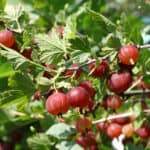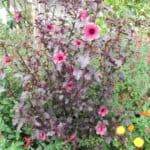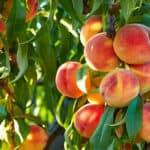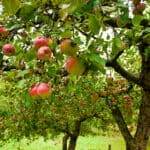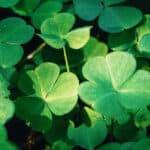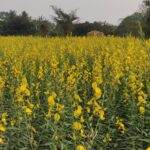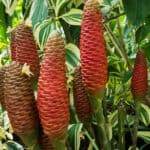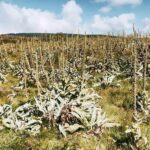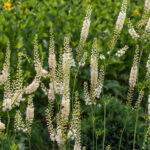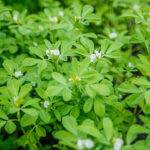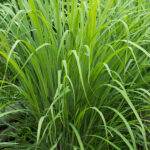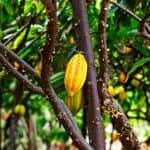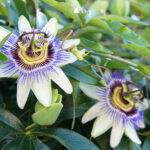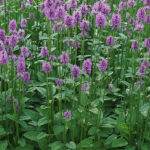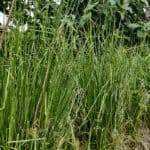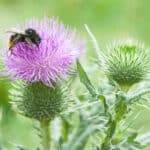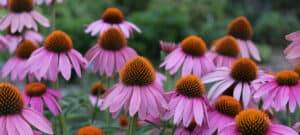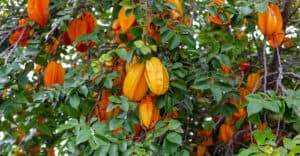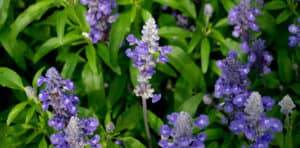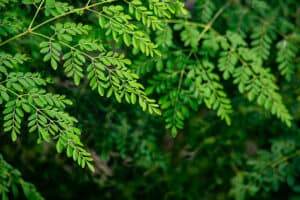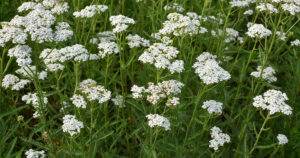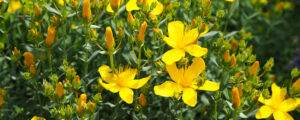Marshmallow is a pleasure to grow in the garden. With its small, hibiscus-like flowers, wonderfully soft leaves, and towering stalks, it’s a beautiful plant to behold. Often, little frogs find shelter on its large leaves, away from the harshness of the sun and amidst the damp, cool air rising from the earth.
Not only is marshmallow a lovely addition to a medicinal garden, but it’s also a staple herb for your home apothecary. Its mucilaginous roots and leaves are used for a wide range of complaints and to help balance out overly dry formulas.
Before we dive into its medicinal properties, I’ll introduce you to marshmallow through a snapshot of its interesting history. Then, I’ll cover everything you need to know about growing, tending, and harvesting this great medicinal ally.
Plant Overview
Marshmallow’s common name was originally merscmealwe, given by the Anglo-Saxons. The old English word mersch means marsh, and mealwe is the name for mallow plants, of which there are thousands across the world. The term ‘marsh’ describes marshmallows favored habitat, which is marshlands, or anywhere the soil stays consistently moist.
Its scientific name, Althae officinalis, was derived from the greek word altho, which means to cure, and officinalis designates this plant as the official medicinal plant of its genus. From the meaning of its scientific name, it’s clear that this was a favored and well-known traditional remedy amongst the Greeks and other Europeans. It is native to Europe, northern Africa, and western Asia. It has naturalized throughout northeastern North America, Australia, and Asia Minor.
The History of Altheae officinalis and Marshmallows
If you’re wondering if the common name of this plant has anything to do with the sweet and puffy candies you find in the store, then you’re right. However, no trace of marshmallow root is found in the white puffy marshmallows in the candy aisle in modern times.
Marshmallows’ recorded use dates back over 2000 years ago. It was first used by the Egyptians and Europeans who used it as food and medicine. The first ‘marshmallow’ was created by the ancient Egyptians who boiled marshmallow root with honey until a thick substance formed. This sweet treat was offered to their gods and royalty. It was also used to soothe sore throats, coughs, and inflamed wounds, much as it used to this day.
In the early to mid-1800s, the French created a candy from marshmallow root called Pâte de Guimauve. This candy was dense and spongy and was made with whipped egg whites, marshmallow root mucilage, and sugar. It was also sold as a soothing treat for sore throats and coughs. The Pâte de Guimauve was the first creation of the modern-day marshmallow but it was still quite different than what we’re familiar with today.
By the late 1800s, candy makers switched from using marshmallow root to modified corn starch and gelatin, which was easier to produce and made the candies fluffier and less dense. That process was improved upon, which created marshmallows as we know them, leaving behind the traditional ingredient that gave the candy its name.
Plant Description
Althea officinalis is an herbaceous perennial; it does not produce any woody stems, and the foliage dies back each year. The roots remain alive (yet dormant) throughout the winter. In the spring, it will send out new growth and can reach up to four feet tall depending on the growing conditions.
The leaves are simple, alternate, and ovate with three to five lobes and irregular teeth. The leaves are much larger at the bottom of the stem and grow smaller as they reach the top. The leaves are around 1 to 3 inches across, depending on where it’s growing on the stem. They are wonderfully soft and velvety on both sides.
By mid-July through August, its upper stems bear small white to pale pink flowers with five petals. They are about 1 to 2 inches across. As the flowers die off, the fruit/seed forms numerous capsules arranged in a circle in the calyx. As the seeds mature, they brown and harden.
The long taproot is 6 to 12 inches when mature with brown skin and white inner flesh.
Propagation and Planting
Marshmallow is relatively easy to propagate and grows in zones 3-9 in full sun to partial shade. It isn’t too picky about soil pH with a tolerable range of 4.8-8.2. However, it does require consistently moist, fertile soil to thrive.
Marshmallow can be propagated from seed or root division. If starting from seed, they should be scarified and given a one-month stratification period for higher germination rates. To scarify the seeds, rub them gently between two pieces of sandpaper. After scarification, there are two ways to give them the necessary stratification period. You can place them in a ziplock baggie filled with a little bit of damp sand and place it in the fridge for a month before you’re ready to plant, or you can plant them in the fall for a natural stratification period. Germination is in about two to three weeks with an optimal soil temperature of 60-65 degrees Fahrenheit. Staggered germination is common.
Root divisions yield a higher success rate than starting marshmallow from seed, but I have had good results with the above process. If propagating root divisions, divide the root crowns in autumn or spring and transplant them into pots or other areas in the garden.
Growth and Care
Althea officinalis can reach 3-4 feet tall and 2-3 feet wide on average, depending on soil fertility. If given optimal conditions, marshmallow can reach close to 5 feet tall, which is what I experienced in my garden.
I started my seeds indoors and then transplanted them out into the garden once they had a few pairs of true leaves. I planted them in a freshly made berm, which included a mix of garden potting soil, soil from the land (fertile, clayey soil), aged horse manure, fresh weeds dug back into the soil, and chicken manure compost. Given the high amount of organic matter available to the hungry marshmallow roots, it grew taller than its average height and produced abundant foliage and flowers. On top of that, I consistently watered so the soil stayed evenly moist. I planted it in an area where it received a little shade in the morning and abundant sun throughout the day.
The key to happy marshmallow plants is rich, fertile soil with plenty of moisture. That said, it prefers well-draining soil, so it shouldn’t be waterlogged.
Whether you have loose sandy soil or hard clay soil, I recommend working the soil before planting your marshmallow and incorporating a good amount of organic compost, bagged garden soil, and/or pine bark fines. This will increase the fertility and soil tilth, which is what marshmallow needs to grow large and abundant. It will tolerate salty soils, as shown by plants that have naturalized in coastal marshes in eastern North America.
It’s best to place marshmallow in a location where it won’t shadow out other plants, where it will be easy to water, and where it can establish itself as a perennial. You could optimize the shade it casts by placing shade-loving plants around it who also like their feet wet. For example, I placed skullcap (Scutellaria lateriflora) next to my marshmallow plants as it also likes consistently moist soil, and the marshmallow provided refreshing shade for it during the heat of the day.
Once established, it should be dressed with compost every year to maintain the rich soil fertility that it loves. To help the plant bush out, pinch back new growth in the spring. Mulch around the plants with pine bark fines, grass clippings, or straw to keep the soil moist and cool and to help suppress weeds.
Pests and Diseases
I did not experience any pests on my marshmallow plants. But, according to other sources, pests to watch out for with marshmallow include flea beetles, apple moths, aphids, and Japanese beetles if they are common in the area. Small insects such as flea beetles, apple moths, and aphids shouldn’t cause too much of a problem if there isn’t a bad infestation of them. They could disfigure the leaves by eating holes in them, but they shouldn’t seriously injure the plant.
According to The Spruce, if flea beetles become a problem, you can apply neem essential oil to the leaves. To do this, combine the oil with water and a drop of soap in a spray bottle and apply it to the leaves, stalk, and base. Before doing this, apply a spot test on a single leaf and wait 48 hours to ensure the neem oil doesn’t negatively affect the plant.
Marshmallow is susceptible to mallow rust, a fungal problem that commonly affects plants in the mallow family, including common mallow and ornamental hollyhocks. It appears as orange-brown spots on the underside of the leaves. This fungus spreads quickly and can cause plants to be stunted, lose their leaves, and possibly die.
To prevent mallow rust, also known as hollyhock rust, The University of Wisconsin Horticulture Extension recommends removing weedy mallow plants, such as the common mallow, which can spread the spores of this fungus. However, the common mallow is also a wild edible great in salads and soups, so I suggest checking the leaves of any common mallow plants and discarding them if they show signs of mallow rust.
Other preventive measures include spacing your marshmallow plants far enough apart to allow plenty of circulation and to avoid overhead watering. If you notice any affected leaves, discard them immediately, and don’t put them in the compost where the spores can continue to spread. They can be thrown away or put in a trash bag and set out in the sun until the plant parts completely break down before they can be put in the compost. Clear away fallen leaves from the base of the plant and avoid overwatering.
Another common fungus marshmallow is susceptible to is Fusarium wilt, which causes the leaves to yellow and wilt. This fungus is preventable by avoiding dense plantings and by watering at the base of the plant rather than overhead, where water can splash onto the leaves. As with mallow rust, clear dead leaves away from the plant’s base and avoid overwatering.
Juliet Blankespoor from The Chestnut School of Herbal Medicine recommends a homemade fungal treatment of fresh garlic and peppermint. To make it, blend them together, let infuse for 30 minutes or so, and strain the liquid into a spray bottle. This spray can then be applied to the plants as a first measure against these fungal issues. It’s best to apply this natural fungicide to your whole patch as soon as you notice a leaf with either of these fungal diseases.
Harvesting
The leaves and the root can be harvested and used for medicinal purposes. The flowers are edible and can be incorporated into salads or as a beautiful garnish atop cakes, pies, and desserts.
The leaves can be harvested just before the plant flowers, as this is when the leaves have the highest mucilaginous content, which is the primary healing property of marshmallow. Harvest the leaves in the morning, just after the dew has dried. To harvest the leaves, you can pick them individually from the stalk or cut a whole stem from the stalk and strip the leaves from the stem. Leave some of the vegetation to ensure vital root production. Dry them in hanging baskets, on screens, or in a dehydrator at a low temperature.
The roots can be harvested in the autumn of the second year or the spring or fall of the third year. However, herbalists have found that the optimal harvest that yields the most mucilaginous roots, and therefore the most medicinal roots, is the fall of the second year.
After harvesting the roots, thoroughly wash them and scrub away any dirt. Slice or chop the roots into pieces. You’ll want to dry them quickly to avoid mildew at temperatures around or above 90 degrees Fahrenheit.
Medicinal Uses
Medicinal Actions:
- Demulcent
- Emollient
- Relaxing expectorant
- Anti-inflammatory (or inflammation-modulating)
- Diuretic
- Mild Astringent/Vulnerary
Parts Used: Leaf and root
Preparation: Infusion, decoction, powder, capsule (marshmallow’s mucilaginous compounds are poorly extracted in alcohol, so tinctures are not recommended)
Marshmallow’s primary and most notable herbal action is demulcent, which are herbs rich in mucilaginous compounds. When extracted, they form a thick, gooey substance, which is why marshmallow was traditionally used to create the famous marshmallow treats.
Demulcents primarily affect the mucosal membranes; they soothe, cool, and moisten the mucosal tissue. They also stimulate the mucosal membranes and enhance mucus secretions. In this capacity, marshmallow is regarded as one of the most powerful and reliable demulcents in Western Herbalism.
The most important aspect to understand about marshmallow is its ability to soothe, moisten, and soften tissues, predominately the mucous membranes in the respiratory, digestive, and urinary systems. While it has a strong affinity for the mucosa, it can also be used for any area of the body that needs moistening and soothing, such as hot, irritated, dry, and inflamed conditions, both internally and externally. It can be applied topically for inflamed wounds and internally for lubricating the joints or connective tissue.
Marshmallow shines when addressing inflammation in the digestive system, such as gastritis, enteritis, and colitis, which is inflammation of the stomach, small intestine, and large intestine. Over time, inflammation can degrade the lining of the stomach and the small and large intestines, resulting in nicks and painful digestive systems. Marshmallow, specifically the root, can be used for these inflammatory conditions in conjunction with other herbs. It adds its inflammation-modulating and soothing properties to the formula and helps to heal the mucosa membranes throughout the GI. With its mild astringent and vulnerary properties, it can heal damage and nicks in the lining of the gut wall while actively lubricating and nourishing the mucosa.
Marshmallow can also be used in formulation for digestive issues such as leaky gut syndrome, GERD, ulcerations, constipation, and antibiotic trauma. The mucilaginous polysaccharides are prebiotic; they produce sugar the gut microbes feed on, which helps to reestablish a healthy gut biome. Marshmallow is effective in restoring a healthy gut biome after antibiotic trauma, along with probiotic supplements and live fermented food.
The same moistening, soothing, and anti-inflammatory benefits can be applied to irritated and dry conditions in the respiratory tract. Such things as sore throats, laryngitis, viral respiratory infections, and dry, hacking coughs can be supported and soothed with marshmallow leaf and/or root. Again, it is best to use marshmallow in formulation for these conditions, alongside antimicrobials, immune stimulants, and alteratives.
It’s important to note that marshmallow is contraindicated in conditions of damp stagnation, such as a wet cough with profuse mucus production. In essence, you don’t want to add a moistening herb to an already damp condition, as it can aggravate it further. However, in the respiratory tract, there can be thick mucus with an unproductive cough. This occurs when there is a build-up of mucus with accompanying inflammation and heat. Herbalist Sajah Popham describes it as, “heat cooking down the fluids, thickening and concentrating them . . . in these situations, marshmallow can be applied, for it helps the mucosal membrane to secrete a fresh layer of mucous that liquefies the hardened, thickened mucous, lifts it away from the membrane, and makes it easier to expectorate.”
For the urinary system, marshmallow is indicated whenever there are dry, hot, and irritated conditions, such as urinary tract infections (UTIs), cystitis (inflammation of the ureters/urethra), and nephritis (inflammation of the nephrons in the kidneys) (Popham, 2019). It will affectly cool and soothe irritation and inflammation, and moisten the mucosal membranes within the urinary tract. For urinary system conditions, the leaf is preferred over the root, as marshmallow leaves have more affinity for the urinary system than the roots do. Moreover, the leaves have more of a diuretic effect than the roots, which points to their medicinal potency being more effective in the urinary tract and kidneys.
As you can see, marshmallow is a relatively straightforward medicinal plant that can be utilized for a wide array of conditions and diseases. It is included in herbal formulas whenever a powerful and reliable demulcent is needed for inflamed, dry, and irritated conditions. It is also commonly used to help balance the energetics of formulas. For example, if a formula includes herbs that are drying and astringent, marshmallow adds a moistening quality to help harmonize the energetics. This is especially important for tonic formulas that need to be taken for an extended time as a way to prevent an individual from drying out.
Final Thoughts
I hope this growing guide has inspired you to try your hand at growing lovely marshmallow. I promise you will be entranced by its velvety leaves and beautiful soft flowers. It creates a safe home for beneficial garden creatures, such as frogs and snakes, and helps provide shade to those nearby.
Plus, marshmallow is a powerful and reliable medicinal herb to have on hand. It can be used for a variety of common ailments you or your family may experience, making it one of the best herbs to have in your home medicine cabinet. It’s easy to grow, easy to prepare, and easy to administer.
May your plant path be blessed, and may you foster a deep connection to the beautiful Althea officinalis.






